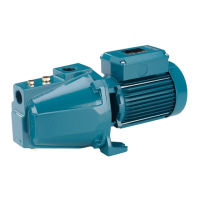Pagina 11 / 64NG,NGL,NGX Rev. 7 - Operating Instructions
EN
8.2 Dismantling the system
Close the suction and delivery gate valves and drain the
pump casing before dismantling the pump.
8.3 Pumps with IP 55 protection (Special construction)
To always assure IP 55 degree of protection, it is necessary
to check the following points:
- Before starting the motors, carefully control the position of
the gasket between terminal box and its cover. For cable
of small size, use a protective covering between cable and
cable gland.
-
When disassembling the end shields of the motors,
restore the existing joint using the sealing glue LOCTI-
TE type 510 or other equivalent sealing system, if any,
and check the perfect assembly of the sealing ring on
the shaft.
9. DISPOSAL
European Directive
2012/19/EU (WEEE)
The final disposal of the device must be done by speciali-
zed company.
Make sure the specialized company follows the classifi-
cation of the material parts for the separation.
Observe the local regulations and dispose the device
accordingly with the international rules for environment
protection.
10 SPARE PARTS
10.1 Spare-parts request
When ordering spare parts, please quote their designa-
tion, position number in the cross section drawing and
rated data from the pump name plate (type, date and
serial number).
The spare parts request shall be sent to CALPEDA
S.p.A. by phone, fax, e-mail.
Changes reserved.
OFF
OFF
11. Troubleshooting
WARNING: Turn off the power supply before performing any operations.
Do not allow the pump or motor to run when dry even for a short period.
Strictly follow the user instructions and if necessary contact an authorised service centre.
OFF
PROBLEM
1) The motor does
not start
2) Pump blocked
3)The pump func-
tions but no water
comes out
4) Insufficient flow
5)
Noise and vibrations
from the pump
6) Leakage from the
mechanical seal
PROBABLE CAUSES
1a) Unsuitable power supply
1b) Incorrect electrical connections
1c) Engine overload protective device cuts in.
1d) Blown or defective fuses
1e) Shaft blocked
1f) Motor failed
2a) Prolonged periods of inactivity .
2b) Presence of solid bodies in the impeller
2c) Bearings siezed
3a) Presence of air inside the pump or suction pipe
3b) Possible infiltration of air.
3c) Foot valve blocked or suction pipe not fully
immersed in liquid
3d) Suction filter blocked
4a) Pipes and accessories with diameter too small
4b) Presence of deposits or solid bodies in the
impeller
4c) Rotor deteriorated
4d) Worn rotor and pump case
4e) Gases dissolved in the water
4f) Excessive viscosity of the liquid pumped
4g) Incorrect direction of rotation
5a) Worn bearings
5b) Unbalanced power supply
6a) The mechanical seal has functioned when dry or
has stuck
6b) Mechanical seal scored by presence of abrasive
parts in the liquid pumped
6c) Mechanical seal unsuitable for the type of
application
6d) Slight initial drip during filling or on first start-up
POSSIBLE REMEDIES
1a) Check that the mains frequency and voltage are suitable.
1b) Connect the power supply cable correctly. Check the setting of the
thermal overload protection.
1c) Check the power supply and make sure that the pump shaft is
turning freely. Check the setting of the thermal overload protection.
1d) Replace the fuses, check points a) and c)
1e)
See “Blocked pump” instruction booklet
1f) Repair or replace the engine.
2a) Unblock the pump by using a screw driver to turn the relevant notch
on the back of the shaft.
2b) Remove any solid foreign bodies inside the impeller
2c) Replace the bearings.
3a) Release the air from the pump using the delivery control valve.
3b) Check which part is not tight and seal the connection.
3c) Clean or replace the bottom valve and use a suitable suction pipe .
3d) Clean the filter, if necessary, replace it . See point 2b) also.
4a) Use pipes and accessories suitable for the specific application
4b) Clean the impeller and install a suction filter
4c) Replace the impeller
4d) Replace the impeller and the pump casing
4e) Perform the opening and closing manoeuvres through the feeder
gate
4f) The pump is unsuitable
4g) Invert the electrical connections in the terminal board
5a) Replace the bearings
5b) Check that the mains voltage is right
In cases 6a), 6b) and 6c), replace the seal
6a) Make sure that the pump casing is full of liquid and that all the air has
been expelled.
6b) Install a suction filter and use a seal suited to the characteristics of
the liquid being pumped.
6c) Choose a seal with characteristics suitable for the specific application
6d) Wait for the seal to adjust to the rotation of the shaft. If the problem
persists, see points 6a), 6b) or 6c).
IST NG_NGX_NGL REV7 05_2021.qxp_MXS 11_03con gall 24/05/21 09:58 Pagina 11

